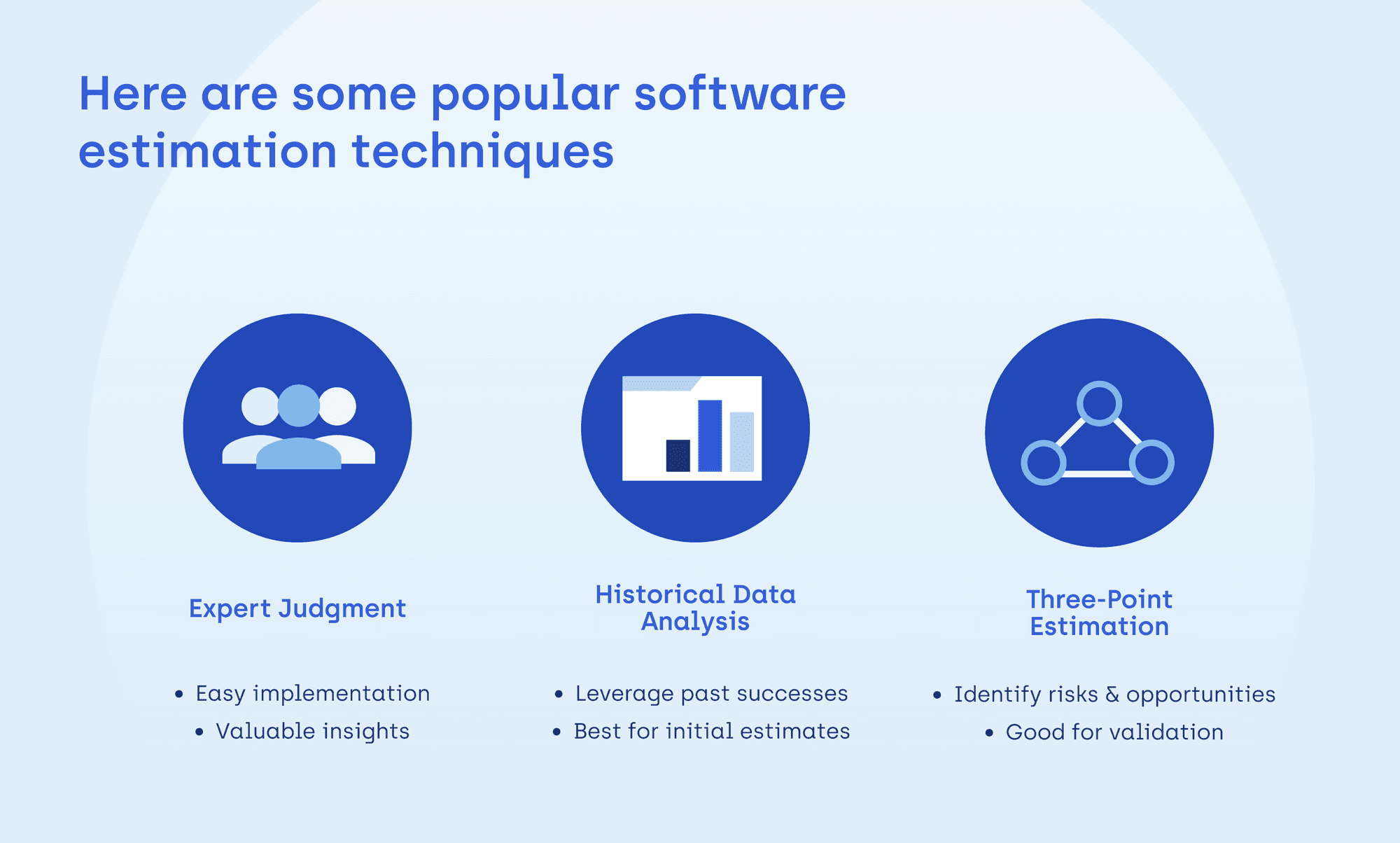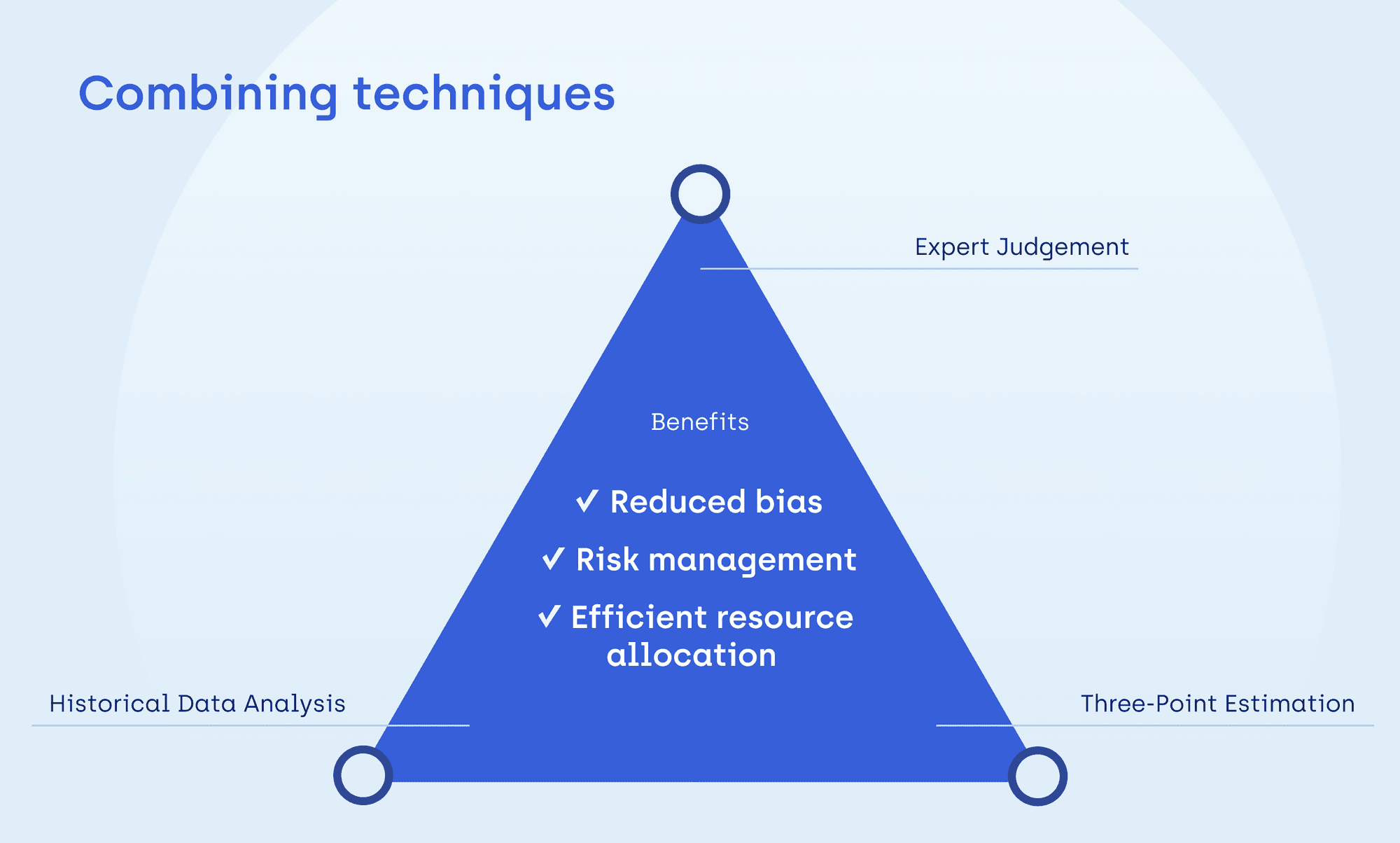The Ultimate Guide to Software Estimation Techniques – Pros, Cons & Strategies for Choosing the Right One

Filip Niedziela

Estimation – the one thing that can truly make or break a software development project! Accurate estimates have the power to launch you into commercial success by allowing you to make data-driven decisions in the project planning, budgeting and managing phases. Meanwhile, over- or under-calculating the costs may dissipate your efforts. As we established in the previous article from this series, there are a lot of factors that go into a thorough project estimation. This time we're going to dive deep into the topic of software estimation techniques.
Welcome to “From Zero to Hero”, a series where you can pick up or revise the fundamentals of complex concepts in just under 10 minutes of reading. Stay with us till the end to learn about the advantages and disadvantages of the most reliable methods. Discover our strategies for choosing the right software estimation techniques for your project.
The basics of project estimation techniques
Before the Estimation
Before we go into the specifics, let's quickly recap what happens before the actual estimation process, in the project planning phase. To approach this task thoroughly, a business analyst has to gain a deep understanding of the industry, market standards, and users’ preferences. As well as refine the project requirements, including various features, functionalities, and specifications. Communication is key, as understanding the client's vision and dispelling possible doubts are also part of this initial phase. Equipped in important information, a business analyst can move to the next stage.
Story Points
While traditional estimates are made in time units, such as days, weeks, or months, agile teams at hero/dot mostly use a different unit of measure, called story points. The main benefit of this approach is that it takes into account the complexity of each user story, the amount of work required, and associated risks. Assigning story points is a collaborative process involving the project team and other relevant stakeholders. They rank the difficulty of each task using a Fibonacci sequence (1, 2, 3, 5, 8, 13, etc.) based on their experience, knowledge and intuition.

Project Estimation Techniques
We've briefly touched on some project estimation techniques in our previous article. Now, we're about to break down in more detail three commonly used and reliable methods. We will dive deep into their respective advantages and disadvantages. As well as provide useful tips on how to reach their fullest potential.
Estimation Technique #1 – Expert Judgment
Widely used and relatively easy to implement, expert judgment relies on valuable insights from professionals with experience in the matter. In this method, a business analyst, project manager and other experts provide time and cost estimates based on their knowledge of technology or past involvement in similar projects.
Pros
- This technique is relatively easy to implement compared to more complex estimation models.
- Expert opinions are a valuable source of first-hand experience, including best practices and potential pitfalls from past projects.
Cons
- Experts may have biases in a particular subject, which can result in inaccurate estimates.
- Finding professionals with relevant experience can pose quite a challenge, especially for more innovative and out-of-the-box projects.
- In some cases, coming to a satisfactory conclusion can be a time-consuming task when there are many aspects to discuss.
Best Practices
- Involve experts from various fields, including business analysts, project managers, developers, testers, and designers, to gain multiple perspectives and reduce bias.
- Clearly define the scope and requirements of the project to guide the professionals you consult for recommendations.
- Document the reasoning behind expert opinions for next stages of the project, as well as future estimations.
Estimation Technique #2 – Historical Data Analysis
Also called analogous estimation, this method involves comparing the current project scope to a project that has been completed in the past. However, the reliability of past project data depends on whether the previous project is comparable in terms of complexity, technology stack and project management methodology.
Pros
- Through taking a retrospective look back, you can leverage previous successes and avoid repeating past mistakes in the current project.
- Historical data analysis is the most time- and cost-effective way of generating initial estimates, allowing you to build up from here.
Cons
- Although comparable to others on some level, each project is completely unique in terms of requirements. Those small but significant differences may lead to less accurate estimates.
- As a result of breakthroughs in technology and constantly changing industry standards, past project data can become... well, out of date.
Best Practices
- Identify sufficiently similar past projects in terms of used technologies and delivered outcomes to inform the estimation process with possibly most relevant data.
- When analysing the data, focus on identifying patterns, trends and potential risks to ensure a successful project estimation.
- If the compared projects are from a while ago, adjust the estimates based on any historical differences, such as different economic realities and progress in technology.
Estimation Technique #3 – Three-Point Estimation
If you're looking for a technique that accounts for project risk estimates associated with the software development life cycle, three point estimating should be your first pick. The overall cost estimate is a result calculated by examining the optimistic, pessimistic, and most likely scenario.
Pros:
- By considering the worst-case scenario, this technique helps a project manager identify potential risks and take proactive measures to reduce them in the early stages.
- Three point estimating encourages open discussion of potential issues and opportunities, which is essential for every successful software development project.
Cons:
- This method is more time-consuming than the former two, as it requires three times the amount of effort to deliver an accurate estimate for each of the scenarios.
- Even with multiple project stakeholders providing their expertise, the entire effort estimation may be subject to common human biases, such as over-optimism or pessimism.
Best Practices:
- When describing the best-case, worst-case, and realistic scenario, make sure that each project estimate is based on realistic assumptions and not a result of biases.
- Use statistics to calculate a weighted average of the three estimates, bringing you closer to the most accurate development estimation.
- As the project progresses, validate and update the project cost estimate based on changes in the scope.

Choosing the Right One
When choosing the right technique, there are various factors to consider, including:
- Project size and complexity
- Formal project management framework
- Timeframe and resources
- Available data
- Estimation Accuracy
An accurate estimate can pave a way for project success by evaluating feasibility, identifying cost-saving opportunities and minimize the risk. On the other hand, over- or under-estimating the resources and effort required may be detrimental to the whole operation. Here, at hero/dot, our experienced business analysts are happy to help you find the most fitting estimation technique that's tailored to your project's individual requirements.
Our Best Practices
- Involve multiple stakeholders: From project managers to project team members, each person involved in the development process has their own perspective. Combining different viewpoints helps reduce bias and lead to more precise results.
- Document the process: Start by defining the specific requirements to guide your further actions. Keep accounts of the reasoning behind experts' recommendation, as they may prove to be extremely useful during next stages of the process or even for next project estimations down the line.
- Include indirect costs: Taking into consideration things such as training, communication, and downtime are a sign of a thorough and holistic project estimation. Additionally, they shouldn't be downplayed, as effective communication is an integral part of any successful project.
- Continuously Improve: Changes in the project scope, unexpected issues or other factors may make your project estimate no longer accurate. Validating and refining your data down the line allows for swift resource allocation before major problems arise.
- Account for changing technology landscape: The tech industry is currently facing challenges related to the rapid rise in popularity of ChatGPT. At hero/dot, we aim to include breakthroughs in technology in our estimations and adjust them accordingly.
Combining Techniques
And now's the time for the most crucial bit of advice. Instead of settling for only one estimation technique, take your analysis to the next level and combine multiple methods. By doing this, you are able to maximize the potential of each approach and produce a more reliable outcome. Let's examine a few ways you can benefit from combining project estimation techniques.
- Reduced estimation bias: Use two or more software estimation techniques to examine the same project aspects, and then take the average of the values to achieve more precise results.
- Better risk management: Compare risk estimation results from different techniques to identify potential discrepancies and sources of problems to eliminate even before they arise.
- More efficient resource allocation: Refine and adjust your cost estimations as the project progresses by using different estimation techniques at different phases of the life cycle.

Conclusion
Now, you've learnt about three most reliable project estimation techniques. We introduced you to the pros and cons of each method, explained our strategies for choosing the right one, and shared our tips for combining various estimation techniques within one project. However, those are only the fundamentals of this vast and complex topic.
If you're looking for a professional who has mastered the art of software estimation and can help you pick the most fitting technique to your individual project requirements, contact us today! Our business analysts and tech experts are here to accurately estimate the effort and resources needed to code your vision.
You may also like:
- Pre-implementation Analysis Done the Hero/dot Way – Build Your Vision of a System Without Code
- Waterfall vs Agile Methodologies: What Are the Differences and Which One Should You Use?
- Software Project Estimation – From Beginner to Intermediate in 10 Minutes
- Request for Proposal (RFP) Explained – Find the Winning Bidder for Your Custom Software Development Project
Need expert assistance with your digital project?


